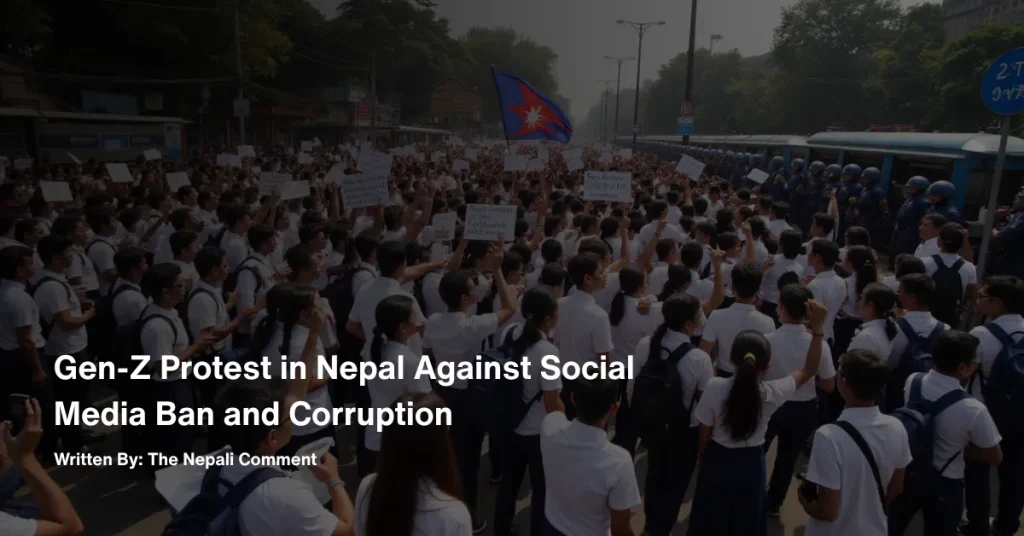1. Background and Context
On September 8, 2025, Nepal witnessed its deadliest youth-led protests in recent history. At least 20 people were killed and over 200 injured when security forces opened fire on demonstrators demanding the end of a sweeping social media ban and action against systemic corruption.
The protests were driven by Generation Z activists, many still in school or university, who grew up in Nepal’s post-monarchy democracy. Disillusionment with corruption, inequality, and repeated government failures had been building for years. The sudden ban on 26 social media platforms served as the catalyst for nationwide mobilization.
2. The Social Media Ban
On September 4, 2025, the government blocked access to 26 major platforms including Facebook, Instagram, WhatsApp, YouTube, X (Twitter), LinkedIn, Snapchat, Reddit, and Discord. Only a handful like TikTok, Viber, and WeTalk remained operational after complying with registration rules under the Directive on Regulating the Use of Social Media, 2023.
Officials justified the ban as a measure against hate speech, fake news, and cybercrime, citing 29,000 complaints in 10 months. Communications Minister Prithvi Subba Gurung argued platforms ignored repeated compliance requests.
But the public saw it as a direct assault on freedom of expression and digital rights. VPN use surged immediately, undermining enforcement and highlighting the ban’s impracticality.
3. Corruption and Economic Frustration
The movement quickly grew beyond digital rights, channeling public rage over decades of corruption and inequality:
- The “Nepo Kids” campaign exposed political elites’ children enjoying foreign education, luxury cars, and expensive trips while ordinary Nepalis lived on a per capita income of $1,300.
- Major scandals reinforced anger:
- The 2017 Airbus deal cost Nepal Airlines $13.38 million in losses, with $2.5 million in bribes exposed in U.S. courts.
- Cooperative fraud schemes, including Oriental Cooperative (Rs 6 billion) and Dev Kumar Nepali (Rs 2.25 billion), wiped out life savings of ordinary citizens.
- Nepal ranked 107th of 180 countries in Transparency International’s 2024 Corruption Perceptions Index.
Economic stagnation and youth unemployment worsened frustration, forcing thousands to migrate abroad for work.
4. September 8: The Protests and Crackdown
- Morning: Thousands gathered in Maitighar Mandala, Kathmandu, chanting slogans like “Shut down corruption, not social media.”
- Escalation: Protesters breached barricades near Parliament in New Baneshwor. Security forces responded with tear gas, water cannons, rubber bullets, and eventually live ammunition.
- Casualties: Hospitals reported 19 deaths, including students with head and chest gunshot wounds, and over 100 injured. Medical staff described chaotic conditions, with tear gas entering treatment wards.
- Spread: Protests erupted in 18+ cities including Pokhara, Biratnagar, Butwal, and Nepalgunj. Curfews were imposed in Kathmandu and Pokhara, with the Nepali Army deployed to reinforce police.
5. Organizers and Coordination
The movement was spearheaded by Hami Nepal, led by Sudhan Gurung, supported by student groups across political parties and civil society organizations like Digital Rights Nepal. Despite the ban, organizers used Discord, Viber, TikTok, and VPNs to coordinate protests nationwide.
Prominent cultural figures, including singer Raju Lama and former Miss Nepal Shristi Shrestha, voiced support, amplifying the movement.
6. Domestic and International Reactions
- Inside Nepal: The Human Rights Commission condemned excessive force, urging restraint. Opposition leaders called for lifting the ban and addressing corruption.
- Internationally:
- The U.S. imposed visa restrictions on officials linked to censorship.
- Amnesty International and the Committee to Protect Journalists condemned lethal force and restrictions on expression.
- Broader global response was muted, with no formal statements from the UN, EU, or SAARC.
7. Implications
The September 8 protests highlight a generational shift in Nepal’s politics:
- Youth Mobilization: Gen Z has emerged as a powerful force, organized, tech-savvy, and unafraid to confront the state.
- Digital Rights Precedent: The protests reinforced how essential online platforms are to modern communication and dissent.
- Crisis of Legitimacy: The government’s violent crackdown deepened mistrust and risked turning a policy dispute into a fight over the very survival of Nepal’s democracy.
- Regional Significance: Parallels with youth-led movements in Sri Lanka (2022) and Bangladesh (2024) suggest Nepal could face similar upheaval if demands remain unmet.
8. Conclusion
The Gen Z uprising of September 2025 was triggered by a social media ban but fueled by years of corruption, inequality, and unkept democratic promises. The government’s resort to live ammunition against largely unarmed students escalated the crisis into one of legitimacy.
This movement reflects more than digital rights; it is a generational demand for accountability and a functioning democracy. Whether it forces reform or faces suppression will shape Nepal’s political trajectory for years to come.

